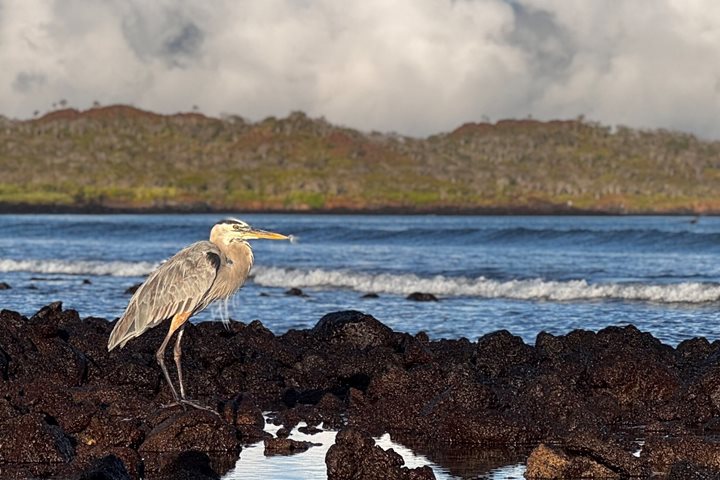We arrived to Floreana quite early today; this island is extremely beautiful, and the early morning colors add to this beauty. We landed at a greenish beach, where sands are composed mainly of a volcanic crystal called olivine. Floreana looks very hilly, and the rains have not started yet; we walked along the trail that took us by a large, shallow lagoon of brackish waters, which is the perfect habitat to a small colony of greater flamingos, one of the native species of the Galápagos Islands. We continued along the trail that crossed a dry forest of ‘palo santos’ or incense trees, which remain leafless until the first rains of the season. At the far end of the trail we found a new beach known as the ‘flour’ beach, due to its fine white sands. This is a favorite nesting beach for the eastern Pacific green sea turtles, and since this is their breeding season, we were able to observe several of them along the shallow waters, either mating or just drifting in the tide. We returned back on board for breakfast; there were more activities to come, and next was a Zodiac ride along the beautiful rocky coastline of a small islet called Champion. Isolated from Floreana, it has been safe from aggressive introduced species, like feral goats or cats, and therefore there are many creatures that are endemic or native in relatively healthy numbers. A particular inhabitant of Champion is the endemic Floreana mockingbird, one of the threatened species of the archipelago; they are usually quite elusive but today made an appearance along the shores of the islet. Champion is also a magnificent snorkeling site, something we could experience today as we had wonderful conditions and an amazing number of fish species, as well as playful Galapagos sea lions during our time in the water!
By the early afternoon we had relocated our anchorage and had already reached Post Office Bay. This is a historical site where a barrel was placed, possibly in the late 1700s, by whalers who wanted to keep in touch with their homes while hunting for sperm whales in the Galapagos. This tradition is kept alive today by the many visitors, us included, that stop at the barrel and take with them a postcard that they can hand-deliver back home. Not far from Post Office Bay lies La Loberia, which translates from Spanish into English to the “sea lion nursery”. La Loberia is a small set of flat, tiny rocks that have been colonized by mangroves and majestic prickly pear trees, as well as a small sized Galapagos sea lion population. In the colors of the afternoon the area looked sublime, either from the Zodiacs as we rode along these islets and rocks or by kayak. Floreana is certainly a fantastic island, where we have been able to experience its richness in both natural and human history.







